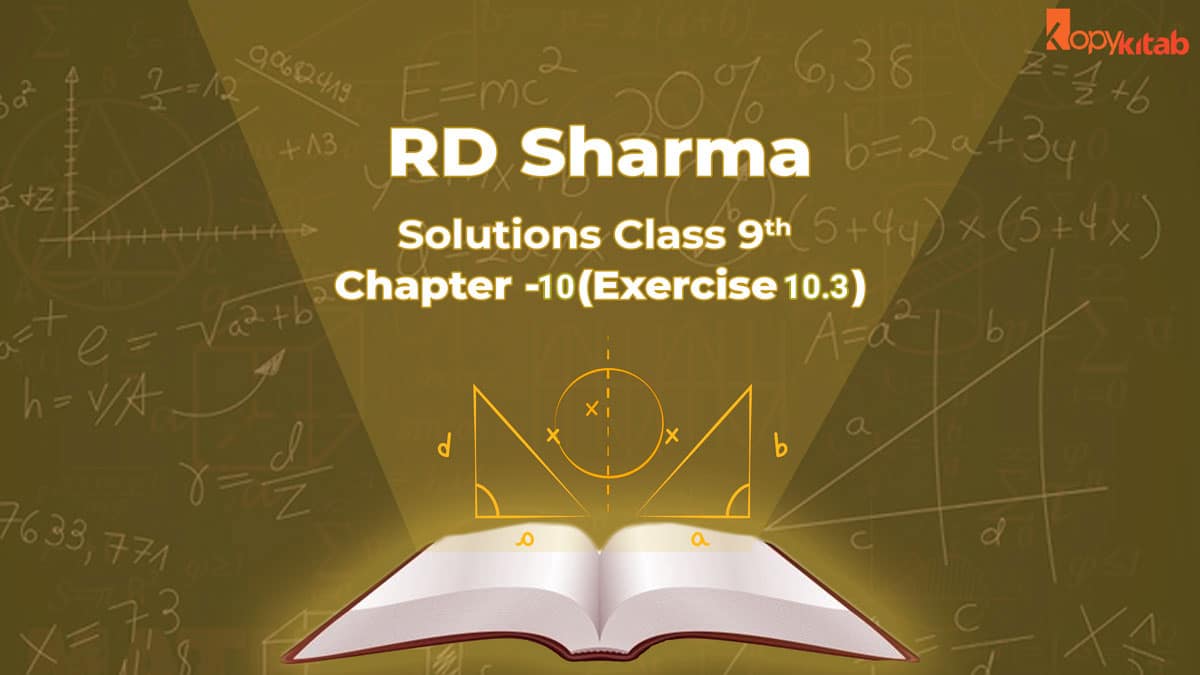
RD Sharma Class 9 Solutions Chapter 10 Exercise 10.3: Want to have the perfect score in the Class 9 Maths exam? Start studying the RD Sharma Solutions Class 9 Maths. It is a much need guide that will clear your doubts and make you score good marks. All the solutions of RD Sharma Class 9 Solutions Chapter 10 Exercise 10.3 are designed by subject matter experts.
Download RD Sharma Class 9 Solutions Chapter 10 Exercise 10.3 PDF
RD Sharma Class 9 Solutions Chapter 10 Exercise 10.3
Access answers of RD Sharma Class 9 Solutions Chapter 10 Exercise 10.3
Question 1: In two right triangles, one side and an acute angle of one triangle are equal to the corresponding side and angle of the other. Prove that the triangles are congruent.
Solution:
In two right triangles, one side and an acute angle of one triangle are equal to the corresponding side and angles of the other. (Given)
To prove: Both triangles are congruent.
Consider two right triangles such that
∠ B = ∠ E = 90o …….(i)
AB = DE …….(ii)
∠ C = ∠ F ……(iii)
Here we have two right triangles, △ ABC and △ DEF
From (i), (ii) and (iii),
By the AAS congruence criterion, we have Δ ABC ≅ Δ DEF
Both triangles are congruent. Hence proved.
Question 2: If the bisector of the exterior vertical angle of a triangle is parallel to the base. Show that the triangle is isosceles.
Solution:
Let ABC be a triangle such that AD is the angular bisector of the exterior vertical angle, ∠EAC and AD ∥ BC.
From figure,
∠1 = ∠2 [AD is a bisector of ∠ EAC]
∠1 = ∠3 [Corresponding angles]
and ∠2 = ∠4 [alternative angle]
From above, we have ∠3 = ∠4
This implies, AB = AC
Two sides, AB and AC, are equal.
⇒ Δ ABC is an isosceles triangle.
Question 3: In an isosceles triangle, if the vertex angle is twice the sum of the base angles, calculate the angles of the triangle.
Solution:
Let Δ ABC be isosceles where AB = AC and ∠ B = ∠ C
Given: Vertex angle A is twice the sum of the base angles B and C. i.e., ∠ A = 2(∠ B + ∠ C)
∠ A = 2(∠ B + ∠ B)
∠ A = 2(2 ∠ B)
∠ A = 4(∠ B)
Now, We know that the sum of angles in a triangle =180°
∠ A + ∠ B + ∠ C =180°
4 ∠ B + ∠ B + ∠ B = 180°
6 ∠ B =180°
∠ B = 30°
Since, ∠ B = ∠ C
∠ B = ∠ C = 30°
And ∠ A = 4 ∠ B
∠ A = 4 x 30° = 120°
Therefore, the angles of the given triangle are 30° and 30° and 120°.
Question 4: PQR is a triangle in which PQ = PR and is any point on the side PQ. Through S, a line is drawn parallel to QR and intersecting PR at T. Prove that PS = PT.
Solution: Given that PQR is a triangle such that PQ = PR and S is any point on the side PQ and ST ∥ QR.
To prove: PS = PT
Since, PQ= PR, so △PQR is an isosceles triangle.
∠ PQR = ∠ PRQ
Now, ∠ PST = ∠ PQR and ∠ PTS = ∠ PRQ
[Corresponding angles as ST parallel to QR]
Since, ∠ PQR = ∠ PRQ
∠ PST = ∠ PTS
In Δ PST,
∠ PST = ∠ PTS
Δ PST is an isosceles triangle.
Therefore, PS = PT.
Hence proved.
This is the complete blog on RD Sharma Class 9 Solutions Chapter 10 Exercise 10.3. To know more about the CBSE Class 9 Maths exam, ask in the comments.
FAQs on RD Sharma Class 9 Solutions Chapter 10 Exercise 10.3
Can I access the RD Sharma Class 9 Solutions Chapter 10 Exercise 10.3 PDF offline?
Once you have downloaded the PDF online, you can access it offline as well.
How much does it cost to download the PDF of RD Sharma Class 9 Solutions Chapter 10 Exercise 10.3?
You can download it for free.


